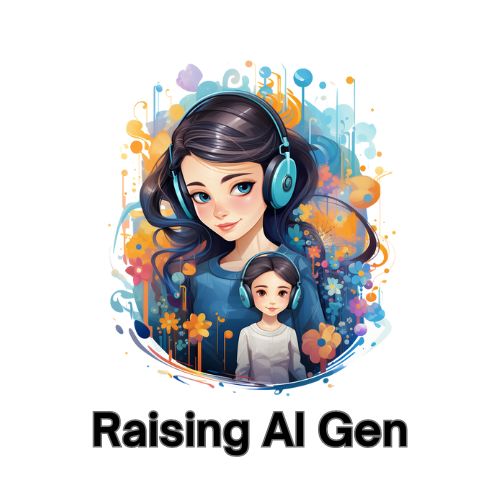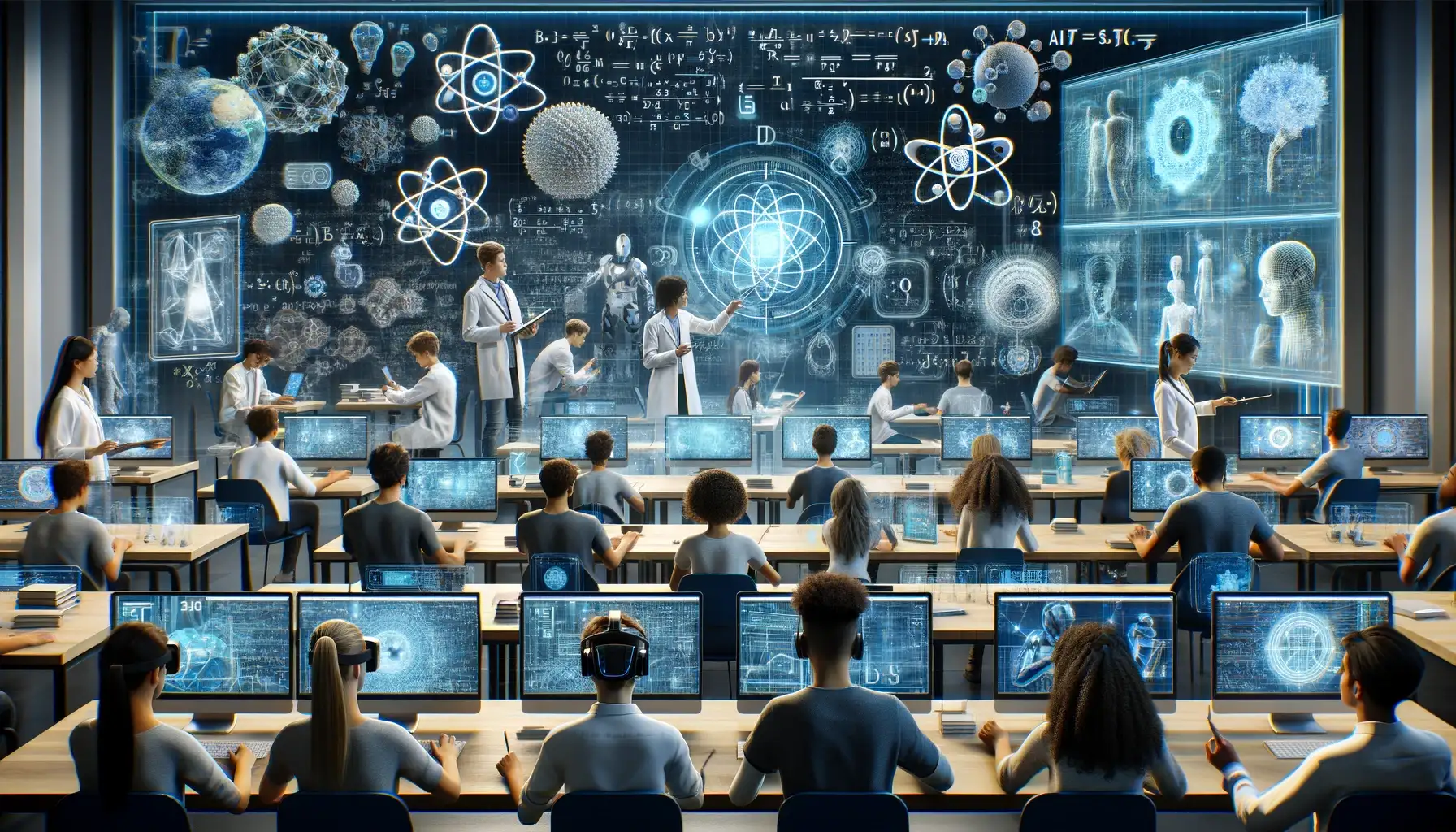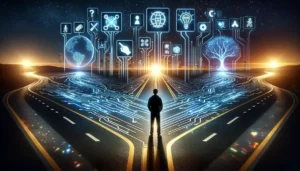Is the future of education being reshaped by robots and algorithms? You bet! In a world where technology is king, AI in STEM education is not just a fancy buzzword—it’s a game-changer.
Imagine a classroom where every lesson is tailored just for you, where your teacher is not only the person at the front but also an intelligent machine that guides you through the complexities of Science, Technology, Engineering, and Mathematics (STEM). Sounds like a sci-fi movie, right?
Well, it’s happening right now, and it’s transforming the way we learn!
AI in STEM education is like having a super-smart buddy who knows exactly what you need to learn and how you learn best. It’s making education more engaging, more personalized, and, dare we say, more fun.
But hold on, it’s not just about making learning cool; it’s about preparing you for a future where AI is as common as smartphones are today.
So, let’s dive into this brave new world of AI-powered learning.
Whether you’re a curious parent, an innovative teacher, or just someone fascinated by the intersection of technology and education, this article is your gateway to understanding how AI is revolutionizing STEM education.
Key Takeaways
Aspect Key Points AI’s Role Transforms STEM education, enhances engagement, and personalizes learning. Tools and Applications Various AI tools like AI Question Paper Generator, Carnegie Learning, etc. Benefits for Teachers Assists in grading, lesson planning, and assessment. Student Preparation Equips students with future-ready skills and AI literacy. Challenges and Considerations Implementation challenges, ethical concerns, and data privacy.
The Role of AI in Enhancing STEM Learning
In the digital age, the role of AI in education is not just supportive; it’s transformative.
Let’s peel back the layers and see how AI is not just changing the game but is the game in STEM education.
Personalized Learning Paths
AI is like a personal coach for every student. It adapts to each learner’s pace, style, and needs, making education a custom-fit suit rather than a one-size-fits-all garment.
Here’s how AI crafts these personalized learning paths:
- Adaptive Learning Algorithms: These smart algorithms analyze how students interact with material, adjusting the difficulty and style of content to match their learning needs.
- Predictive Analytics: AI can predict where students might struggle and provide additional resources, ensuring no one is left behind.
Interactive and Engaging Learning Environments
Gone are the days of passive learning. AI brings an interactive twist to STEM education:
- Virtual Labs: AI-powered simulations allow students to conduct experiments in a virtual world, making learning not just informative but also immersive.
- Gamification: By turning lessons into games, AI makes learning addictive. Who knew algebra could be as engaging as your favorite video game?
Real-World Problem Solving
AI doesn’t just teach; it challenges. It presents students with real-world problems, encouraging them to apply their STEM knowledge in practical, meaningful ways.
Enhanced Collaboration
AI fosters a collaborative learning environment. It connects students from around the globe, allowing them to work on projects together, share insights, and learn from diverse perspectives.
Continuous Feedback and Assessment
With AI, feedback is not just an end-of-term report card. It’s a continuous, real-time process that helps students understand their progress and areas for improvement.
- Instant Grading: AI tools can instantly grade assignments, providing immediate feedback to students.
- Progress Tracking: AI systems track student progress over time, highlighting growth and areas that need attention.
Preparing for the AI-Driven Future
By integrating AI into STEM education, we’re not just teaching students about AI; we’re preparing them for a future where AI is ubiquitous.
It’s about building AI literacy, ensuring that the next generation is ready to thrive in an AI-driven world.
🔗 To delve deeper into how AI can support students, check out How AI Can Help Students, a comprehensive guide that explores the myriad ways AI is empowering learners.
Innovative AI Tools in STEM Education
Embark on a digital odyssey through the landscape of STEM education, where innovative AI tools and applications are reshaping the learning experience.
These aren’t just tools; they’re catalysts for curiosity, understanding, and discovery.
Area9 Learning: The Adaptive Pioneer
Area9 Learning stands at the vanguard of adaptive learning, offering a personalized educational experience that’s as unique as each learner’s brain. Its “biological model” adapts in real-time, ensuring efficient and effective learning.
Kami: The Digital Classroom Companion
Kami transforms static documents into interactive learning experiences. As a comprehensive PDF annotator, it enables students to engage with educational materials actively, while teachers can assign, assess, and provide feedback with unparalleled ease.
PhET: Interactive Simulations for Science and Math
PhET Interactive Simulations, born from the University of Colorado Boulder, offers a suite of free, engaging simulations in math and science. These tools encourage exploration and discovery, making complex concepts accessible and enjoyable.
Desmos: The Graphing Revolution
Desmos is more than a graphing calculator; it’s a gateway to understanding complex mathematical concepts. With its intuitive interface and powerful features, Desmos is democratizing mathematics for students and educators alike.
GeoGebra: A Unified Mathematics Experience
GeoGebra brings together geometry, algebra, spreadsheets, graphing, statistics, and calculus in one dynamic package. It’s a testament to the interconnectedness of mathematics and a powerful ally in STEM education.
These tools are not just revolutionizing the way we learn; they’re preparing students for a future where technology and education are inextricably linked.
| Feature | Area9 Learning | Kami | PhET Interactive Simulations | Desmos | GeoGebra |
| Type of tool | AI-powered learning platform | AI-powered annotation and collaboration platform | Interactive simulations | Online graphing calculator | Online geometry software |
| Target audience | Students in grades 6-12 | Teachers and students | Teachers and students | Teachers and students | Teachers and students |
| Key features | Personalized learning experiences, real-time feedback | Interactive tools for annotating, collaborating, and assessing digital content | Hands-on simulations for learning about STEM concepts | Graphing and mathematical tools for learning about mathematical concepts | Dynamic diagrams and mathematical calculations for learning about geometric concepts |
| Cost | Paid | Paid | Free | Free | Free |
| Integrations | Popular learning management systems | Popular learning management systems | None | Popular learning management systems | Popular learning management systems |
Embrace these innovations, and watch as the classroom transforms into a realm of endless possibilities.
Personalized Learning Through AI
In the realm of STEM education, AI is the maestro orchestrating a symphony of personalized learning experiences. It’s not just about teaching; it’s about understanding each student’s unique learning journey and tailoring the education to fit like a glove.
AI: The Ultimate Personal Tutor
Imagine a tutor who knows not just your name, but your strengths, weaknesses, and even your favorite way to learn. That’s AI in a nutshell.
- Adaptive Learning Platforms: Tools like Area9 adapt to each student’s learning style, ensuring no one gets left behind.
- Customized Feedback: AI provides feedback that’s as unique as the learner, turning every assessment into a stepping stone for improvement.
The Power of Data in Personalization
AI doesn’t guess; it knows. By harnessing the power of data, AI creates learning paths that are evidence-based and effective.
- Learning Analytics: AI tools analyze how students interact with material, fine-tuning the learning experience.
- Predictive Insights: AI can foresee potential stumbling blocks, providing preemptive support to keep students on track.
Breaking Down Barriers
AI in STEM education is not just a tool; it’s a bridge, connecting students from diverse backgrounds to a world of opportunities.
- Language Learning Tools: AI applications like Duolingo use adaptive technology to make language learning more accessible and effective.
- Specialized Support: For students with special needs, AI tools provide tailored support, ensuring an inclusive learning environment.
The Future is Personalized
As we march into the future, one thing is clear: personalized learning through AI isn’t just a trend; it’s the new standard in education.
🔗 To explore the transformative impact of AI on personalized learning, dive into AI Personalized Learning, a resource that delves into the heart of AI-driven educational innovation.
AI as the Teacher’s Sidekick
In the dynamic world of STEM education, AI isn’t just a tool for students; it’s a superhero sidekick for teachers, amplifying their abilities and supercharging their teaching methods.
Let’s unveil how AI is revolutionizing the educator’s role.
Streamlining Administrative Tasks
Teachers, wave goodbye to the mountains of paperwork! AI is here to streamline your administrative workload.
- Automated Grading: Tools like Kami can grade assignments in a flash, giving teachers more time to focus on what they do best—teach.
- Attendance and Record Keeping: AI systems keep track of attendance and records, ensuring that teachers have all the information they need at their fingertips.
Enhancing Lesson Planning
With AI, lesson planning is not just easier; it’s smarter. AI provides insights and resources that enrich the curriculum and captivate students.
- Curriculum Development: AI analyzes educational trends and student data to suggest the most effective teaching strategies and materials.
- Resource Recommendation: AI recommends resources tailored to the class’s needs, ensuring that every lesson is a hit.
Fostering Professional Growth
AI isn’t just a tool; it’s a teacher’s professional development partner, offering insights and opportunities for growth.
- Feedback on Teaching Methods: AI provides constructive feedback on teaching methods, helping educators refine their craft.
- Professional Development Resources: AI suggests courses, webinars, and materials for teachers to continue their professional growth.
The Future of Teaching with AI
The future is bright for educators who embrace AI. It’s not about replacing teachers; it’s about empowering them to reach new heights in their profession.
🔗 To delve deeper into how AI is supporting educators, check out AI Tools for Teachers, a comprehensive guide that explores the myriad ways AI is empowering educators.
Navigating the Ethical Maze of AI in STEM Education
As we embrace the AI revolution in STEM education, it’s crucial to navigate the ethical labyrinth with a compass of responsibility and foresight.
Let’s dissect the ethical considerations and challenges that come with integrating AI into the learning landscape.
Data Privacy: A Paramount Concern
In an era where data is gold, protecting student information is not just a priority; it’s a sacred duty.
- Consent and Transparency: Ensuring that all data collection is transparent and consensual is the cornerstone of ethical AI in education.
- Robust Data Protection: Employing state-of-the-art security measures to safeguard student data from breaches is non-negotiable.
Bias and Fairness: Leveling the Educational Playing Field
AI is only as unbiased as the data it’s fed. Ensuring fairness and equity in AI-driven education is a mission, not just a statement.
- Diverse Data Sets: Utilizing diverse data sets in AI algorithms is crucial to prevent biases and ensure equitable learning experiences.
- Continuous Monitoring: Regularly auditing AI systems for biases helps maintain a fair and inclusive educational environment.
The Human Touch: Irreplaceable and Vital
Amidst the digital dazzle, let’s not forget that the human element in education is irreplaceable. AI is a tool, not a teacher.
- Emotional Intelligence: AI may be smart, but it lacks the emotional intelligence that teachers bring to the classroom.
- The Role of Educators: Teachers are the conductors of the educational symphony, guiding and interpreting the music that AI helps compose.
Crafting an Ethical AI Framework
Creating an ethical AI framework in education isn’t just a good practice; it’s a blueprint for a future where technology and humanity harmonize.
- Stakeholder Collaboration: Involving educators, students, parents, and policymakers in crafting ethical AI guidelines ensures a holistic approach.
- Ethical AI Literacy: Educating all stakeholders about the ethical implications of AI fosters a culture of informed and responsible use.
The Future of AI in STEM Education: A Brave New World
As we stand on the cusp of a new era in STEM education, it’s clear that AI is not just a fleeting trend but a transformative force shaping the future of learning.
Let’s peer into the crystal ball and envision the brave new world of AI-enhanced education.
Personalization at Scale
The future of STEM education is not one-size-fits-all; it’s tailor-made for every learner.
- Hyper-Personalized Curriculums: AI will craft learning experiences that adapt to each student’s pace, style, and interests.
- Predictive Analytics: AI will not just react but predict, offering personalized learning paths before students even know they need them.
The Teacher-Student-AI Triad
In the classroom of the future, teachers, students, and AI will form a powerful triad, each playing a distinct yet harmonious role.
- Teachers as Guides: Educators will evolve from information deliverers to learning facilitators, mentors, and guides.
- Students as Explorers: Empowered by AI, students will become explorers of knowledge, charting their own course through the vast seas of information.
- AI as the Enabler: AI will be the silent enabler, the wind in the sails of the educational voyage, making the journey smoother and faster.
Breaking Down Walls
The future of STEM education is without walls, transcending physical and geographical barriers.
- Global Classrooms: AI will connect students from around the world, fostering global collaboration and understanding.
- Lifelong Learning: AI will make learning a lifelong journey, accessible to all, regardless of age, location, or background.
Embracing the Future with Optimism and Caution
As we embrace this future, let’s do so with optimism tempered by caution, ensuring that AI serves as a force for good in education.
- Ethical Stewardship: We must be ethical stewards of AI, ensuring it’s used responsibly and for the benefit of all.
- Inclusive Design: AI must be designed inclusively, with the needs and voices of all learners and educators at the forefront.
🔗 To continue exploring the fascinating world of AI in education, check out The Future of AI in Education, a thought-provoking dive into what lies ahead.
As we conclude this journey, remember that the future of AI in STEM education is not just about technology; it’s about people.
It’s about empowering every learner and educator to reach their full potential. The future is bright, and it’s ours to shape. Let’s make it a masterpiece.
Frequently Asked Questions (FAQs)
Below is a table format FAQ section addressing common questions about AI in STEM education:
| Question | Answer |
| What is AI in STEM education? | AI in STEM education refers to the integration of Artificial Intelligence technologies to enhance learning and teaching experiences in Science, Technology, Engineering, and Mathematics. |
| How does AI personalize learning? | AI personalizes learning by analyzing individual student data to tailor educational content, pace, and learning styles, ensuring a more effective and engaging learning experience. |
| Can AI replace teachers in the classroom? | No, AI is not meant to replace teachers but to assist and enhance their teaching capabilities, allowing them to focus more on student engagement and personalized instruction. |
| Is data privacy a concern with AI in education? | Yes, data privacy is a significant concern. Ethical use of AI in education involves transparent data collection, informed consent, and robust data protection measures. |
| How can AI help students with special needs? | AI can provide customized support and learning tools tailored to the unique needs of students with disabilities, ensuring an inclusive and accessible educational environment. |
| What are the challenges of implementing AI in schools? | Challenges include ensuring data privacy, preventing biases in AI algorithms, providing adequate teacher training, and securing funding for technology integration. |
| How does AI support STEM teachers? | AI supports STEM teachers by automating administrative tasks, enhancing lesson planning with data-driven insights, and providing professional development resources. |
| Will AI change the future of STEM education? | Yes, AI is poised to significantly change the future of STEM education by enabling personalized learning, breaking down geographical barriers, and fostering lifelong learning opportunities. |
Further Reading
Here’s a table of blog posts from Raising AI Gen that are connected to the keyword “AI in STEM education”. These articles will provide additional insights and information on the topic:





